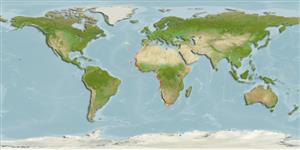Common names from other countries
Environment: milieu / climate zone / depth range / distribution range
Ecologia
; intervalo de profundidade 12 - 400 m (Ref. 435), usually 50 - 150 m (Ref. 435). Tropical
Eastern Atlantic: West Africa from Sahara to Angola.
Length at first maturity / Tamanho / Peso / Idade
Maturity: Lm ? range ? - ? cm Max length : 7.6 cm CL macho/indeterminado; (Ref. 435)
Maximum carapace width: 9.6 cm. Burrows in mud or sandy mud at depths of 12 to 400m, common at depths of 50 to 150 m (Ref. 435).
Life cycle and mating behavior
Maturidade | Reprodução | Desova | Ovos | Fecundidade | Larvas
Members of the order Decapoda are mostly gonochoric. Mating behavior: Precopulatory courtship ritual is common (through olfactory and tactile cues); usually indirect sperm transfer.
Fischer, W., G. Bianchi and W.B. Scott (eds.). 1981. (Ref. 435)
Status na Lista Vermelha da IUCN (Ref. 130435)
Status no CITES (Ref. 108899)
Not Evaluated
Not Evaluated
Perigo para os humanos
Harmless
Uso pelos humanos
Pescarias: de interesse potencial
| FishSource |
Ferramentas
Mais informação
Idade/TamanhoCrescimentoComprimento-pesoComprimento-comprimentoMorfologiaLarvasAbundância
Fontes da internet
Estimates based on models
Preferred temperature
(Ref.
115969): 14.2 - 20.5, mean 16.7 (based on 50 cells).
Vulnerabilidade
Low vulnerability (10 of 100).
Categoria de preço
Unknown.
